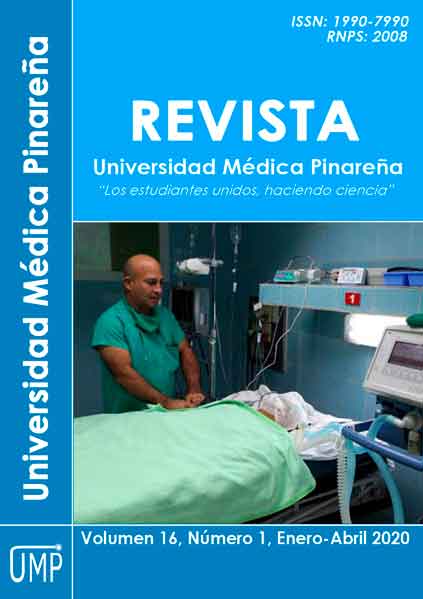Cranioencephalic trauma in patients treated at “Dr. Carlos Juan Finlay” Central Military Hospital
Keywords:
Brain Injuries, Traumatic, Craniocerebral Trauma, Craniotomy, Glasgow Coma Scale, Surgical Procedures, Operative.Abstract
Introduction: traumatic brain injury is one of the major public health problems in contemporary society.
Objective: to characterize patients treated with head trauma at Dr. Carlos Juan Finlay Central Military Hospital.
Methods: an observational, descriptive and cross-sectional study was conducted. The target group consisted of 115 patients with a diagnosis of cranioencephalic trauma; the whole target group was included in the study. Demographic variables were analyzed; type of lesion, initial evaluation according to the Glasgow coma scale, mortality, surgical procedures and complications. A descriptive analysis was performed using absolute and relative percentage frequencies for the qualitative variables, and for the quantitative variables, the arithmetic mean and standard deviation were established.
Results: the most representative ages were between 19 and 33 (28 %), with mild trauma predominating (72 %). The mortality rate ranged 14 %; the most frequent lesions were cerebral contusion and chronic subdural hematoma (22 %). The most frequent procedures were trepanation and evacuation (46 %). Respiratory infections predominated as a complication (36 %).
Conclusion: young-aged patients and in early third age prevailed. A low mortality rate was obtained. Nearly half of the patients underwent surgery, where trepanation and evacuation were the surgical procedures most applied, as seen in relation to the removal of chronic subdural hematomas. More than half of those studied were free of complications.
Downloads
References
2. Mosquera Betancourt G, Van Duc H, Casares Delgado JA, Hernández González EH. Caracterización de los pacientes con traumatismo craneoencefálico y lesión axonal traumática. AMC [Internet]. 2016 [citado 10 Jun 2019]; 20(6): 609-618. Disponible en: http://scielo.sld.cu/scielo.php?script=sci_arttext&pid=S1025-02552016000600004&lng=es.
3. Rodríguez A, Cervera E, Tuesca R, Flórez K, Romero R, Villalba PJ. La detección tardía de neurodeterioro en etapa aguda incrementa la letalidad por trauma craneoencefálico. Biomédica [Internet]. 2020 [citado 2019 Jun 15]; 40(1): [aprox. 29 p.]. Disponible en: https://revistabiomedica.org/index.php/biomedica/article/view/4786
4. Schouten, Joost W.; Maas Andrew, I. R. Epidemiology of Traumatic Brain Injury. In: H. Richard Winn, MD: Youmans, Neurological Surgery. Sixth Edition. Volumen 4, Chapter 323. Philadelphia: Elsevier. 2011. P. 3270-3276.
5. Serviá L, Badia M, Monserrat N, Trujillano J. Gravedad en pacientes traumáticos ingresados en UCI. Modelos fisiológicos y anatómicos. Med Intensiva [Internet]. 2019 [citado 2019 Jun 15]; 43(1): 26-34. Disponible en: https://reader.elsevier.com/reader/sd/pii/S021056911730339X?token=D0FFE4CAAA4E1FE3605F532BCA6220A0DFEF326B8CD060663DE25B0D9E5BC7BDBA827B43120F63EC07F605339704A1AC
6. De La Cruz Torres LC, García Silverio AG, Díaz Burgos RV, Rodríguez Peña S, López Lara CE. Trauma craneoencefálico en motociclistas, Hospital Traumatológico Ney Arias Lora. Enfermería Investiga, Investigación, Vinculación, Docencia y Gestión [Internet]. 2016 [citado 2019 Jun 15]; 1(4): 141-144. Disponible en: https://dialnet.unirioja.es/servlet/articulo?codigo=6194281
7. Boto GR, Gómez PA, Cruz J De la, Lobato RD. Modelos pronósticos en el traumatismo craneoencefálico grave. Neurocirugía [Internet]. 2006 Jun [citado 10 Nov 2019]; 17(3): 215-225. Disponible en: http://scielo.isciii.es/scielo.php?script=sci_arttext&pid=S1130-14732006000300001&lng=es
8. Gómez Taibo ML, Pérez García EM. La intervención de la comunicación aumentativa y alternativa en el traumatismo craneoencefálico. Rev Inv Logopedia [Internet]. 2018 [citado 10 Jul 2019]; 8(1): 43-62. Disponible en: https://dialnet.unirioja.es/servlet/articulo?codigo=6940048
9. García Gómez A, Pérez García AR, Gutiérrez Gutiérrez L, León Robles M, Santamaría Fuentes SJ, Bestard Pavón LA. Comportamiento de factores pronósticos clínicos y demográficos relacionados con el traumatismo craneoencefálico. Rev Cub Med Mil [Internet]. 2010 Jun [citado 10 Oct 2019]; 39(2): 95-103. Disponible en: http://scielo.sld.cu/scielo.php?script=sci_arttext&pid=S0138-65572010000200004&lng=es
10. Bonow RH, Barber J, Temkin NR, Videtta W, Rondina C, Petroni G, et al. The Outcome of Severe Traumatic Brain Injury in Latin America. World Neurosurg [Internet]. 2018 [citado 2019 Jun 15]; 111: e82-e90. Disponible en: https://www.clinicalkey.es/#!/content/playContent/1-s2.0-S1878875017321046?returnurl=null&referrer=null
11. Vasconcelos AC, Dias Capistrano J, Wippel Ristow MP, Vieira Andrade W, Meneses Silva I, Ribeiro Gonzaga MA, et al . Epidemiological Aspects of Cranioencephalic Trauma at Cuiabá Municipal Hospital, Brazil. Int. J. Odontostomat. [Internet]. 2018 Mar [cited 2019 Dec 13]; 12(1): 29-34. Disponible en: https://scielo.conicyt.cl/scielo.php?script=sci_arttext&pid=S0718-381X2018000100029&lng=en
12. Amado Donéstevez de Mendaro AR, Cañizares Luna O, Alba Pérez LC, Alegret Rodríguez M. Neurologic and epidemiologic characterization of frontal head trauma during a period of five years in Villa Clara. Medicentro Electrónica [Internet]. 2017 Mar [citado 10 Jul 2019]; 21(1): 30-38. Disponible en: http://scielo.sld.cu/scielo.php?script=sci_arttext&pid=S1029-30432017000100005&lng=es
13. Kaul RP, Sagar S, Singhal M, Kumar A, Jaipuria J, Misra M. Burden of maxillofacial trauma at level 1 trauma center. Craniomaxillofac Trauma Reconstr [Internet]. 2014 [citado 10 Jun 2019]; 7(2): 126-30. Disponible en: https://www.ncbi.nlm.nih.gov/pmc/articles/PMC4078188/
14. Mosquera Betancourt G, Vega Basulto S, Valdeblánquez Atencio J, Varela Hernández A. Protocolo de Manejo Hospitalario del Trauma Craneoencefálico en el Adulto Mayor. AMC [Internet]. 2010 Feb [citado 2019 Dic 13]; 14(1). Disponible en: http://scielo.sld.cu/scielo.php?script=sci_arttext&pid=S1025-02552010000100014&lng=es
15. V. da Costa LG, CarmonaI MJ, Malbouisson LM, Rizoli S, Rocha-Filho JA, Galesso Cardoso R, et al. Independent early predictors of mortality in polytrauma patients: a prospective, observational, longitudinal study. Rev Clinics [Internet]. 2017 [citado 10 Nov 2019]; 72(8): 461-468. Disponible en: Disponible en: http://www.scielo.br/scielo.php?script=sci_arttext&pid=S1807-59322017000800461&lng=en&nrm=iso&tlng=en







